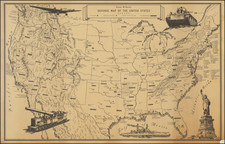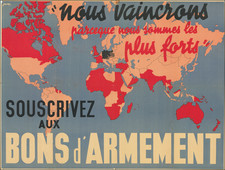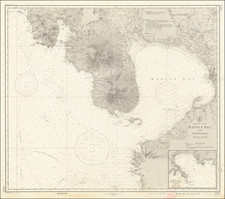One of the Most Important Battle Maps in American History - Here in the Rare Second Beach Obstacle Overprint Variant.
A rare and remarkable original Second World War planning map depicting the Normandy coast at Grand Hameau des Dunes, Ravenoville, better known today simply as Utah Beach. This rare "Second Beach Obstacle Overprint" was issued less than a week before D-Day and bearing the ultra-secret “BIGOT” classification.
“But nothing was more secret—or more vital to Operation Neptune—than the mosaic of Allied intelligence reports that cartographers and artists transformed into the multihued and multilayered BIGOT maps.” (Thomas B. Allen, “Untold Stories of D-Day,” National Geographic Magazine, June 2002, vol. 201, no. 6, p. 15)
Below the map is a panoramic landscape photograph of the landing area with annotations labeling houses, beach exits, and other landmarks.
Utah Beach - North
The present map is one of a pair of maps - the other being "Utah Beach - South" - that covered the westernmost of the five code-named landing beaches in Normandy. Northern Utah Beach was initially intended to be the landing zone for the 4th Division, however, the realized landing zone was farther to the south, with U.S. forces working their way into this area along the roads near the beach but not directly from the beach itself.
Known States
This is the most desirable presentation of the map; showing the beach obstacles as they were known one week before D-Day.
- Without overprinting, most commonly from the Neptune Monograph.
- "FIRST BEACH OBSTACLE OVERPRINT- Information as of 12 May" (Overprint in Red)
- "SECOND BEACH OBSTACLE OVERPRINT- Information as of 30 May" (Overprint in Purple)
A legend lists symbols for the following beach obstacles:
Hedgehogs in Line
Hedgehogs Grouped
Element "C"
Ramps
Stakes
Curved Rails
And the following land obstacles:
Anti-Tank Ditch
Road Block
Clearly Defined Mines
Ends Undefined
Undefined Mine Field
Reported Mine Field
Number of Rows
Distance Between Rows
Spacing Between Mines
Simple Four Row Field
The BIGOT classification
This map is prominently stamped in green, “TOP SECRET – BIGOT UNTIL DEPARTURE FOR COMBAT OPERATIONS—THEN THIS SHEET BECOMES RESTRICTED.” Introduced during the Second World War, BIGOT was the highest-level military security classification, above Top Secret. Some sources suggest that it was an acronym for “British Invasion of German Occupied Territory;” others, that it was a “backronym” for “To Gib,” the code stamped on the papers of officers headed to Gibraltar in advance of the 1942 North Africa invasion.
Whatever the origins of the term, extraordinary efforts were made to protect BIGOT-level material. When for example a practice landing (“Operation Tiger”) on the Devon coast was ambushed by U-Boats, Eisenhower himself ordered the recovery of the bodies of the ten known victims with BIGOT clearance. This was necessary to prove that they had not been captured alive, as their capture would have compromised the invasion plans and necessitated its cancellation.











![[ Bosnia ] Izlozba Drazavni Osiguravajua Zavod Direkcija za nr Bosnui Hercegovinu (Exhibition of The Insurance Institute Directorate of Bosnia Herzagovina)](https://storage.googleapis.com/raremaps/img/small/50706.jpg)
![(Second World War - NVKD SMERSH) Übersicht der Verkehrsverbindungen mit Sonntagsrückfahrkarte von Berlin. Gültig während des Winterfahrplans 1938/39 [Overview of the Transport Links with Sunday return ticket from Berlin. Valid During the Winter Timetable 1938/39]](https://storage.googleapis.com/raremaps/img/small/69563.jpg)



![Newsmap. Monday, November 2, 1942 [on verso:] There Is No All-Purpose Plane](https://storage.googleapis.com/raremaps/img/small/93348.jpg)